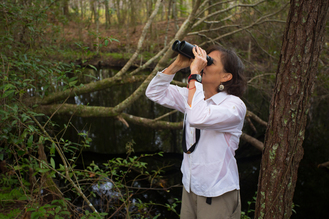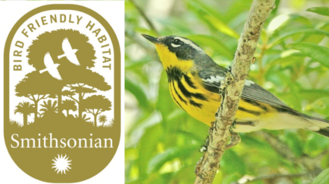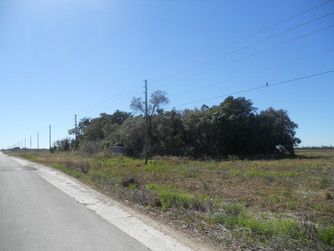 Photo by David Moynahan.
Many birders appreciate that the hobby of bird watching can be a relaxing escape from the pressures and stresses of daily life, but did you know there is research to back this up? A study published by researchers at the University of Exeter showed that neighborhoods with more birds and more vegetation are associated with lower levels of stress, anxiety, and depression! Other studies have shown that just spending time in nature can measurably lower our stress hormones, relax our pulse and lower our blood pressure.
These benefits apply whether you are an expert birder chasing new species for your list or a backyard observer who prefers to watch from the comfort of your patio. You don’t even have to be able to identify the species you see. We aren’t doctors, so please don’t take this information as medical advice – but if you need another excuse to go birding, this is a great one! Take a mindful moment to watch birds today, whether on the trail or in your backyard.
 Bananaquits are occasionally spotted as vagrants in the Florida Keys. Photo by Reiner Munguia.
Warbler Neck: The neck strain you might experience after peering up through binoculars at birds in the treetops; named for warblers because of their habitat of perching and flitting about very high in trees.
Example: My friends don’t think that birding is a physically challenging hobby, but that’s just because they’ve never climbed a mountain for a rare high elevation species or been struck with a terrible case of warbler neck.
Vagrant: A stray bird showing up well outside of its normal range.
Example: Birders in south Florida are delighted when they find vagrant birds like La Sagra’s Flycatcher or Bananaquit that typically are only found in the West Indies.
Fallout: Don’t panic if you hear a birder use this term in the springtime! In the birding world, fallout refers to a weather event forcing birds to stop in large numbers during migration.
Example: I hear the fallout in the Keys has been incredible this year – people have been seeing 25 warbler species in one day!
A grammar bonus for all of you bird nerds who are also word nerds:
To capitalize or not to capitalize? Though common names of birds are not considered proper nouns by a general audience, many birders and ornithologists capitalize official common names.
Example: I can’t believe my English professor tried to correct my grammar when I wrote “Prothonotary Warbler.” She is clearly not a birder!
 Magnolia Warblers are often found on shade-coffee plantations in the winter. Photo by Andy Wraithmell, FWC.
There are many ways that we can help migratory warblers here in Florida when they are nesting or passing through, including creating backyard habitat and protecting wild lands. But what can we do to help them when they head further south in the winter?
Luckily, when you need a little caffeine jolt to get going in the morning or to make it through an afternoon slump, there is an easy (and enjoyable) way for you to help birds! Some coffee is being produced on shade-coffee plantations in Central and South America. These plantations maintain an overstory above their crop, and many strive to keep the overstory made up of diverse native trees. Unlike a field of coffee plants growing in full sun, these shaded farms provide habitat and food for wintering birds. By buying bird-friendly, your money is providing incentives for farmers to fight deforestation. Look for the Smithsonian Bird Friendly Coffee seal of approval.
There are additional efforts to make agricultural practices for growing other crops more bird-friendly, including cocoa beans and wine grapes! Who knew that conservation could be so delicious?
 While perhaps not much to look at, Lucky Hammock boasts an impressive diversity of birds, with 226 species on the list! Photo by FWC.
Frog Pond Wildlife Management Area and its neighbor to the south, Southern Glades Wildlife and Environmental Area, encompass 32,000 acres of wetlands and prairie in Miami-Dade County, dotted with hardwood hammocks and cypress forest. There are many opportunities for hiking and biking, including the 13-mile South Dade Greenways Trail and the 2.5-mile shell rock levee road. These areas support 24 threatened or endangered plants and animals, including the Cape Sable Seaside Sparrow.
For birders, the highlight of this expansive park is a single quarter-acre hammock known as Lucky Hammock, and with good reason – 226 species have been spotted here! During spring migration, you can potentially see upwards of 30 species of wood warbler. In the winter, keep your eyes peeled for the Painted Bunting and winter sparrows. This site also boasts multiple sightings of rare birds, including the Sulphur-bellied Flycatcher, Tropical Kingbird, Townsend’s Warbler and Yellow-headed Blackbird.
Address: SW 232 Ave., Homestead, FL 33034
Contact: (561) 686-8800
Hours: Daily, sunrise to sunset
Fees: None
March 2 – Bird and Nature Tour (St. Marks)
March 3 – Birding 101 at Fort Mose (St. Augustine)
March 7 – The Birds and the Bees Presentation (Palm Coast)
March 12 – Birding Trip to Werner-Boyce Springs State Park (Spring Hill)
March 16 – Manatee County Preserves Trip (Bradenton)
March 23 – Jumping Gully Preserve Trip (Spring Hill)
March 23 – Ocala National Forest Bird Walk (Silver Springs)
March 21 – Native Planting for Wildlife (Orlando)
March 27 – Pine Flatwoods Preserve Guided Nature Walk (St. James City)
March 30 – Aripeka Sandhills Preserve Trip (Hudson)
Check out the events page of our website for more events across the state!
Do you know about any other bird or wildlife-related events going on in Florida? Help spread the word by letting us know! Send in the times, dates, locations and contacts to wildlifeviewing@myfwc.com for posting on the Great Florida Birding and Wildlife Trail website.
Events must be related to birds or other wildlife and must be open to the public. Examples include interpretive programming, summer camps and family programs.
|